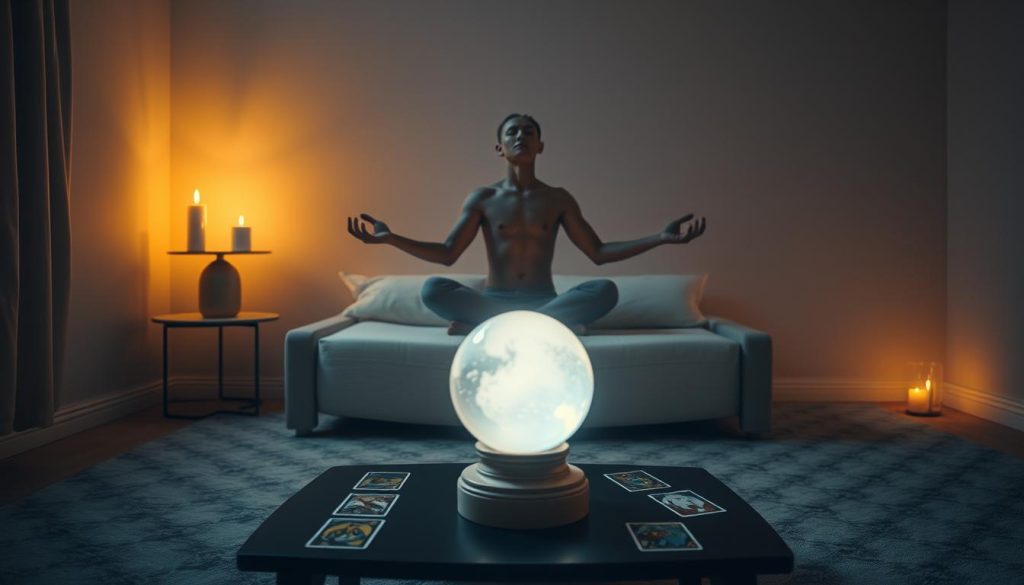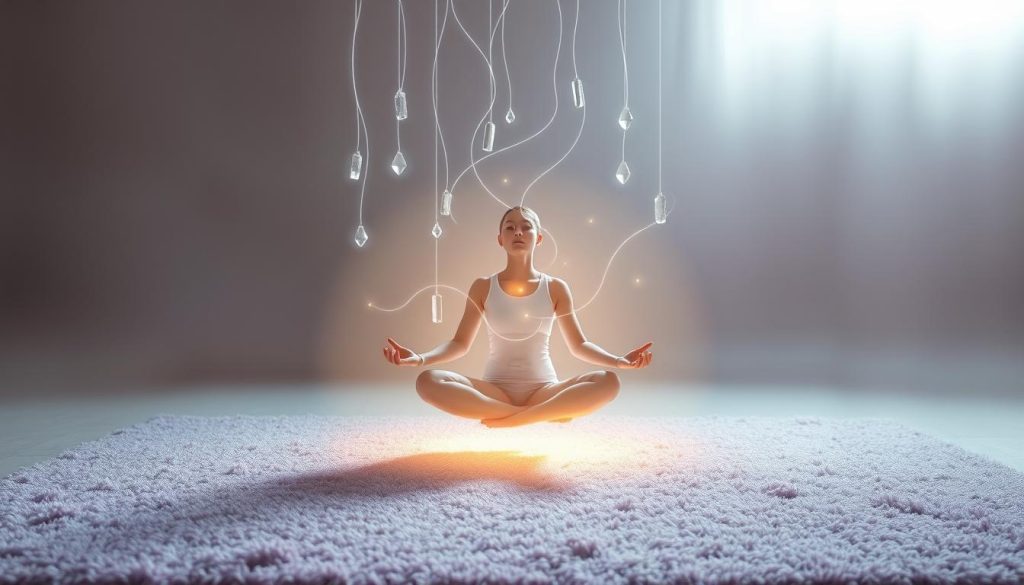We know a good night’s sleep shapes health, mood, and the way we meet the day. Yet many Americans miss out, restless at night and carrying tired thoughts into morning.
This page sets the scene: simple guided practices that help the body relax, the mind quiet, and the heart slow. Mindfulness and meditation can nudge hormones like melatonin and serotonin, calm racing thoughts, and make it easier to fall into deep sleep.
Think of this as a playful toolkit. We’ll share short meditation scripts, gentle visualizations, and easy ways to record your voice or use calming recordings. Small rituals — dim lights, a brief stretch, a written to‑do list — make a big difference.
Expect cozy, research‑backed tips and neat audio ideas you can try tonight. Together we’ll turn bedtime into a tiny ritual of wonder, so every night feels softer and more supported.
Why Self‑Hypnosis and Guided Meditation Help You Drift into Deep Sleep
Nighttime rituals that calm the nervous system make falling asleep feel less like a battle and more like a gentle landing.
Research shows meditation triggers the relaxation response. Heart rate slows, breathing eases, and stress hormones fall. These shifts create the right physiological state to fall into deep sleep.

Mindfulness meditation reduces rumination by offering a steady, gentle focus. When thoughts have a soft anchor, anxiety eases and the mind untangles. That helps nights feel calmer and less scattered.
Simple daytime moves add power. A short stretch, a written to‑do list, dim lights, and shutting electronics 30–60 minutes before bed set a steady runway. Over time, we train our system to expect calm at bedtime.
Guided meditation gives structure. Personalized practice nudges the experience further, so we become our own mindfulness meditation teacher. Small cues and a kind tone build a ritual your body learns to trust.
Self-Hypnosis for Sleep: Free Scripts and Tools for Deep Rest
Here’s a tidy collection of easy meditations and hypnotic cues that help the mind unwind.
We gathered ten styles you can try tonight: ocean and lake imagery, a full body scan, soft‑belly breathing, gratitude, and gentle countdowns. A beginner meditation script uses a stair countdown and a beach visualization. Best practice: lie down and record with pauses so the pacing feels spacious.

Practical uses include recording your own voice, reading to loved ones, or sharing guided meditation scripts with clients and listeners. We note which picks calm quickly and which support deeper unwinding for chronic restlessness.
Short on time? Find sub‑10‑minute techniques and longer sessions when you want a more spacious ritual. We also flag sensory anchors—countdowns, breath cues, and imagery that help visualization relax mind.
This page is your starter kit. Bookmark it to return when you want a new trail into deep sleep and a session that feels made just for you.
Free Guided Sleep Meditation Scripts You Can Use Tonight
Here are simple, ready-to-use meditations to calm a busy mind and ease you toward sleep.
Begin with the beginner-friendly “Sleep Visualization for Deep Rest.” Gaze at a single spot. Blink slowly while counting 10 to 0. Gently close your eyes and take a soft stair countdown to 1. Step into warm white sand and notice the texture beneath your feet. This short meditation script is designed to relax the mind in under 10 minutes and help you fall asleep.

Record the guided meditation script in your own voice. Slow pacing and generous pauses let the body follow. Lie down when you practice and allow imagery to form without rushing.
Other meditation scripts to explore: a Bedtime Mindfulness body scan, a “Soft Belly” breath practice, and “Breathe Away Anxious Thoughts.” Choose sub‑10‑minute options when hours are tight; longer reads are lovely on calmer nights.
Share a favorite on this page with listeners who like gentle structure. Use sensory cues — “warm sand underfoot” — as visualization relax mind prompts. Repeat your favorites until the script becomes a reliable cue for deep sleep and helps you fall asleep more easily.
Free and Low‑Cost Sleep Tools: Hypnotic Podcasts, Stories, and Sessions
Press play and let a gentle narration carry you toward rest.

Sleep Magic is a weekly podcast hosted by hypnotherapist Jessica Porter. Episodes blend hypnosis, meditation, and bedtime stories to help listeners drop into sleep and wake restored.
New free episodes arrive every Wednesday. A premium tier via Supercast or Apple Podcasts removes ads and adds biweekly bonus releases and the full archive for $9.99/month or $79.99/year. Guests include sleep scientist Dr. Sophie Bostock.
Listeners praise Jessica’s calming voice and vivid imagery, though some prefer minimal ambience. Choose episodes with light sound design if effects pull you out.
Use a sleep timer so each guided meditation session fades as you nod off. Pair one of these episodes with a single breath cue from earlier sections to deepen health benefits and invite deep sleep.
Tap the page’s favorites list and share tracks on social media when a story helps your circle. These modern tools fit busy life—dim lights, press play, and give yourself time to remember how to rest.
How to Use Sleep Scripts: Recordings, Live Readings, and Bedtime Routines
Let’s map practical ways to use meditation scripts so bedtime feels gentle and predictable.
Record your favorite meditation script in your own voice. Slow pace and soft tone help the body learn the cue. Title files clearly — like “10‑minute beach unwind” — so you can find them when you’re sleepy.

Read live to loved ones. A calm presence can soothe children and partners more than any recording. Try the “read first, then recall” method: read aloud once, then close your eyes in bed and let memory guide the rest.
Best practices: lie down to practice, model generous pauses, and make a quiet, safe space to close your eyes. Dim lights and gentle stretching signal the day is ending.
Keep sessions simple. Use one or two cues, consistent timing each night, and blend techniques — a guided meditation script followed by three quiet minutes works well. Notice what helps and tweak gently; small changes unlock better nights.
Beginner Quick‑Start: A Five‑Minute Wind‑Down That Actually Works
Start small: five quiet minutes that teach your body how to unwind. Lie down, make the room dim, and give yourself a single, gentle task.

Minute 1: Gaze softly at a spot. Blink slowly while counting 10 to 0. This signals the mind that night is near.
Minute 2: Close your eyes. Sweep attention from scalp to toes. Invite each area to soften.
Minute 3: Breathe into the belly. Try four seconds in, six out. Let the breath move you into a calmer state.
Minute 4: Picture warm sand holding your body. Imagine it taking what you don’t need and keeping what soothes you.
Minute 5: Whisper a short cue — “I release the day; I welcome rest.” Let the phrase sink in and wait. You may fall asleep. You may not; both are fine.
Keep it simple: no phone, no audio. Repeat nightly. If thoughts pop up, smile inwardly and return to breath. This tiny ritual helps us fall asleep with steady ease and invites deeper, softer sleep over time.
Choose the Right Technique for Your Night: A Mini‑Guide
Pick a practice that answers what your evening is asking. We match technique to symptom so you can fall asleep with less fuss and more ease.

If your mind races, try visualization—ocean or lake imagery fills the mind with gentle pictures and tames busy thoughts.
Tight chest or shallow breathing? Use the “Soft Belly” breath method. Longer exhales calm the nervous system and nudge the body toward deep sleep.
Restless legs or jittery energy? A Bedtime Mindfulness body scan helps steady attention and release tension one small area at a time.
Carrying heavy feelings? Try gratitude or gentle mental reframing. These meditation approaches soften emotion without pretending it isn’t real.
On anxious nights, go minimal: short guided meditation passages, longer silence, and a kinder tone. Short on time? Two minutes of focused breath beats skipping practice and supports long‑term health.
Listeners who love story can lean into guided tracks—soft narratives work like lullabies for adults. Save 2–3 favorites on this page so decision fatigue won’t keep you awake.
Trust your inner compass: if a method feels right tonight, it probably is. Small, steady choices create a calmer state and healthier sleep over time.
Add Mindful Sleep Hygiene to Boost Every Script’s Effect
A few simple evening habits amplify every meditation session and make bedtime gentler.
Bring mindfulness into the day so night arrives with less friction and more flow. Close loops with a quick to‑do list at the end of the workday. Your mind prefers clear containers; that tiny act frees energy and quiets thoughts.
Dim lights an hour before bed or light a candle. Teach your body clock to recognize night without negotiation. Turn off electronics 30–60 minutes before sleep and swap scrolling through social media for a warm shower or gentle stretches.
Sprinkle short mindfulness meditation breaks into the day. Those micro‑pauses make it easier to release tension later and improve overall health. Notice caffeine, heavy meals, and alcohol timing—these levers shape how many good hours you get.
If you guide others, share simple mindfulness teaching about light and screens. Consider a brief check‑in with a meditation teacher or mindfulness meditation teacher for tailored tweaks.

Buy mindfulness tools only if they simplify your life. The most powerful change is often free, small, and repeatable—something you can do every night to invite a good night sleep and a calmer life.
Settle In for the Night: Your Path to Calm, Consistent, Restorative Sleep
Begin tonight with one clear habit—one breath, one phrase, one scene—and watch rest arrive.
Choose one script, one cue, and one breath pattern. Dim lights, put devices away, and use a short guided meditation or the stair‑countdown beach meditation script to help you fall asleep. Keep the bed sacred and gentle.
Repeat what works every night. Rotation helps when you need variety: visual, breath, or story meditations. Share notes with listeners or others who want to help find small shifts.
If you teach, fold brief mindfulness teaching into closings. When you’re ready, connect with a meditation teacher and only buy mindfulness add‑ons that truly simplify your routine. Return to this page any time; we’ll wander back together and let the body, the mind deep, and the thoughts remember relaxation and a steady state of deep sleep.
